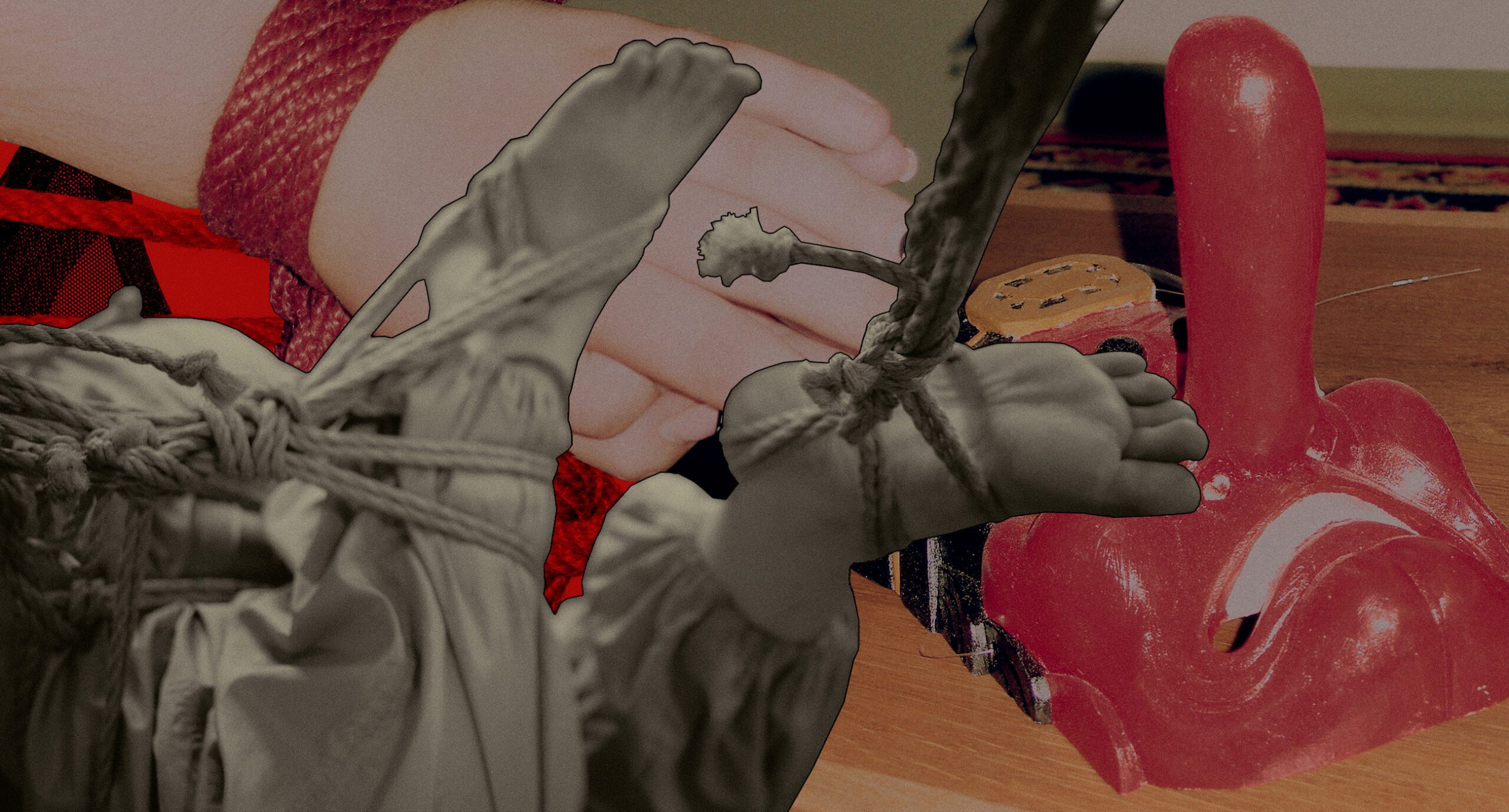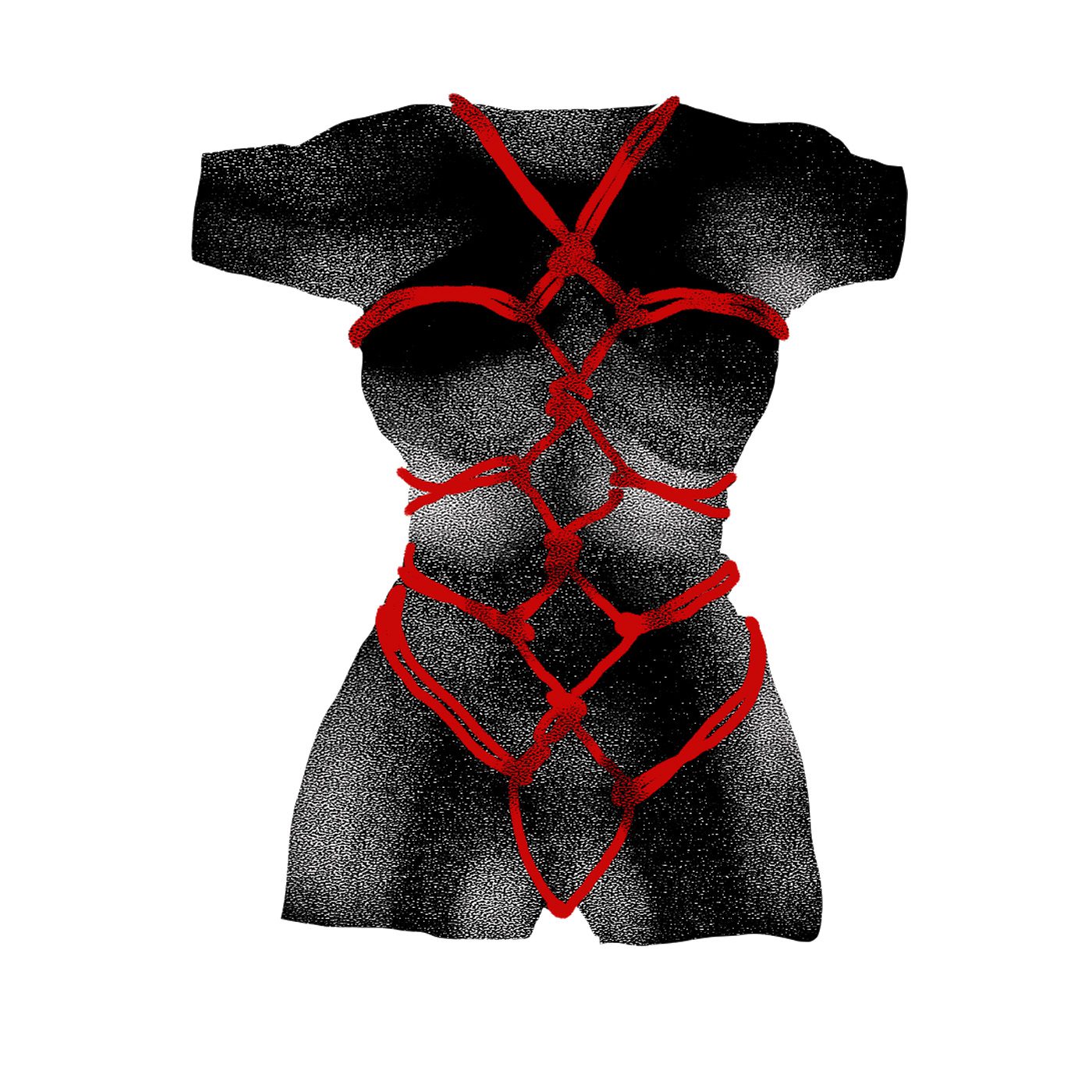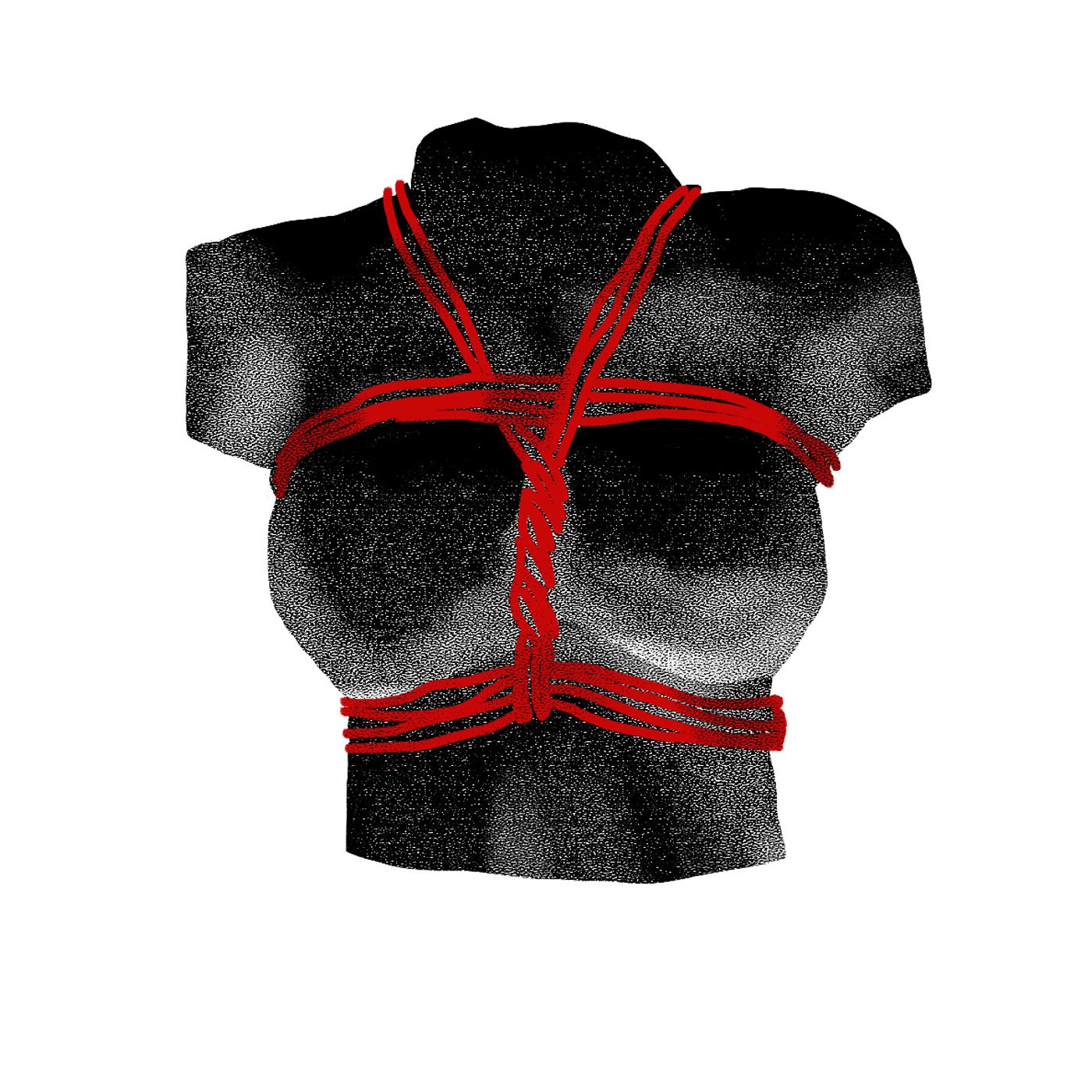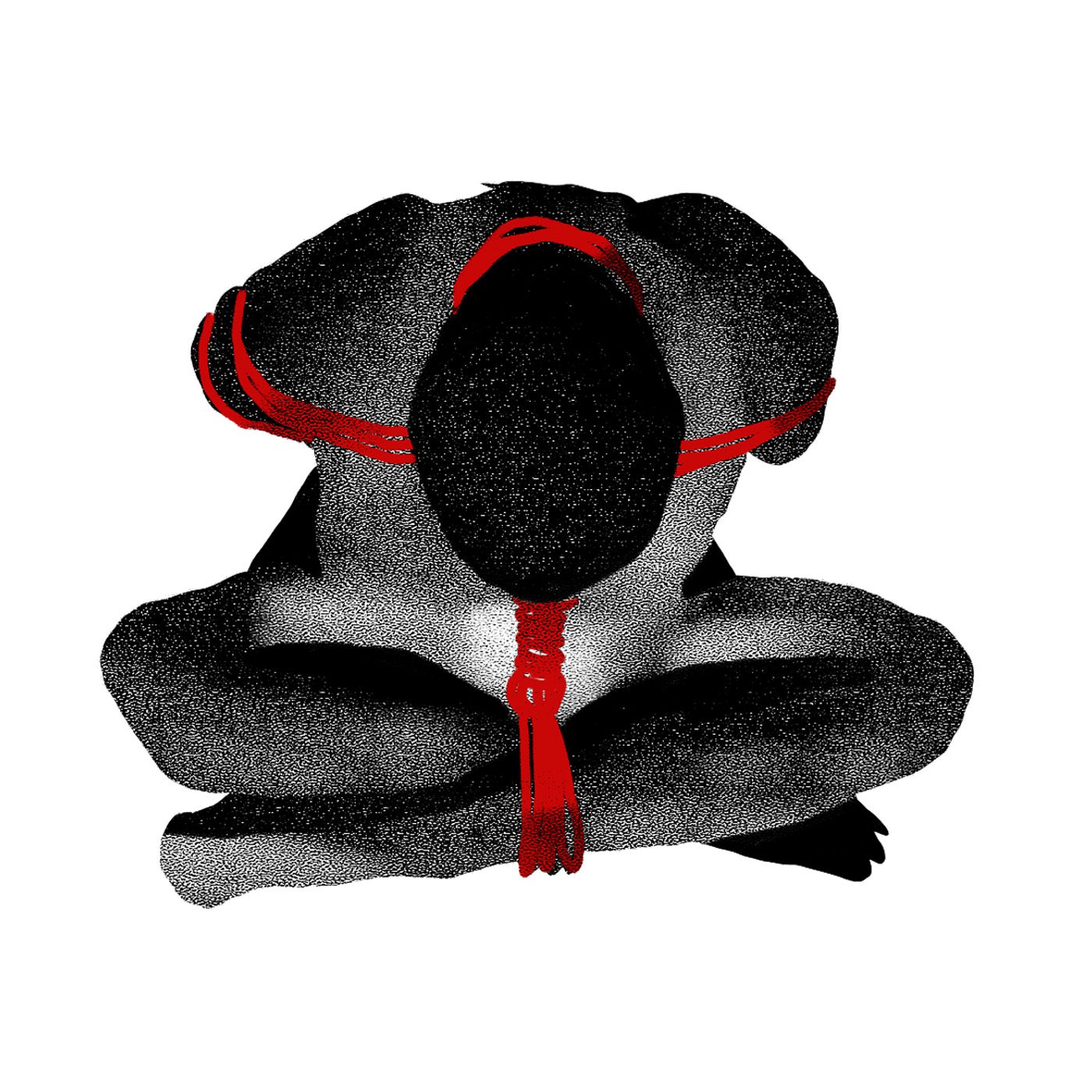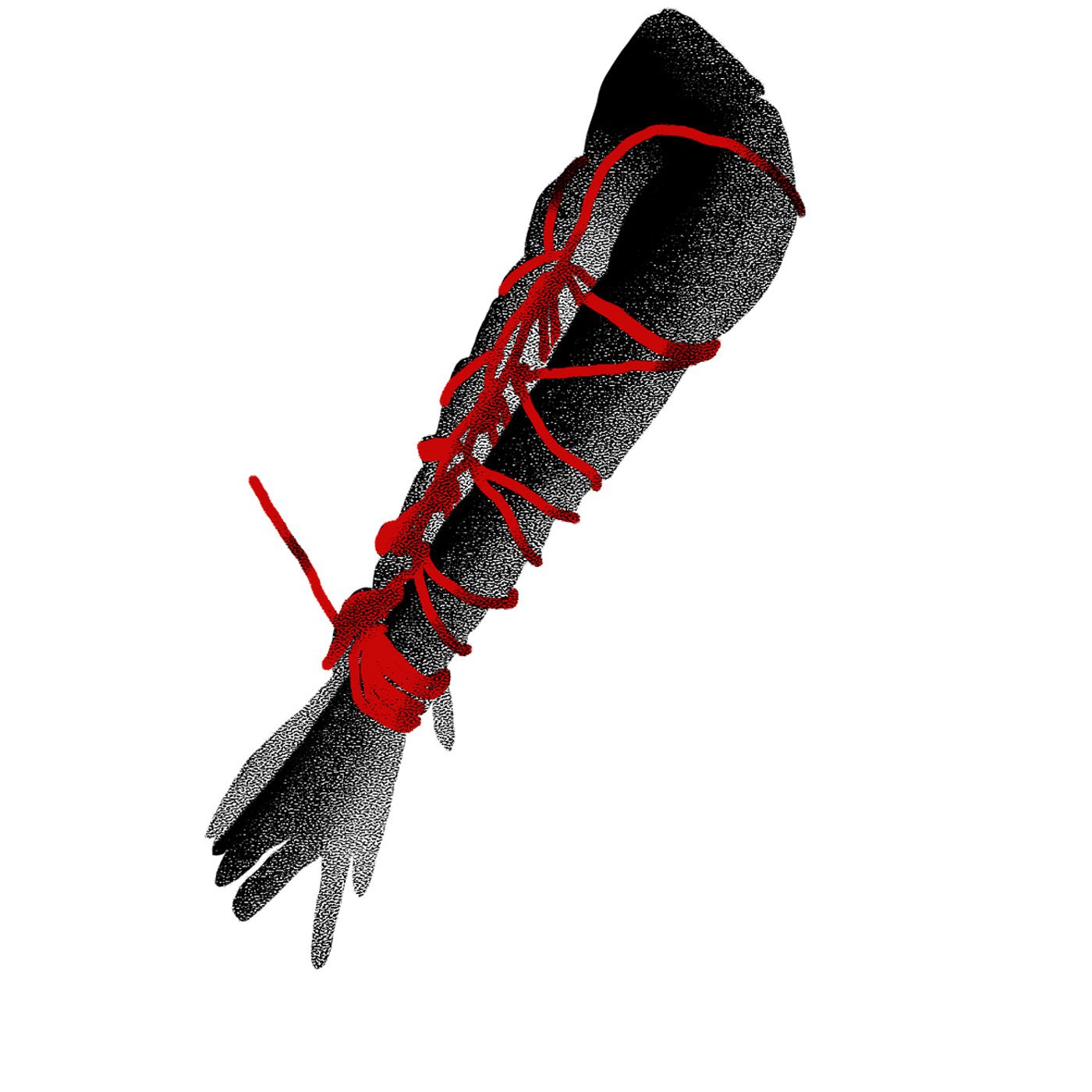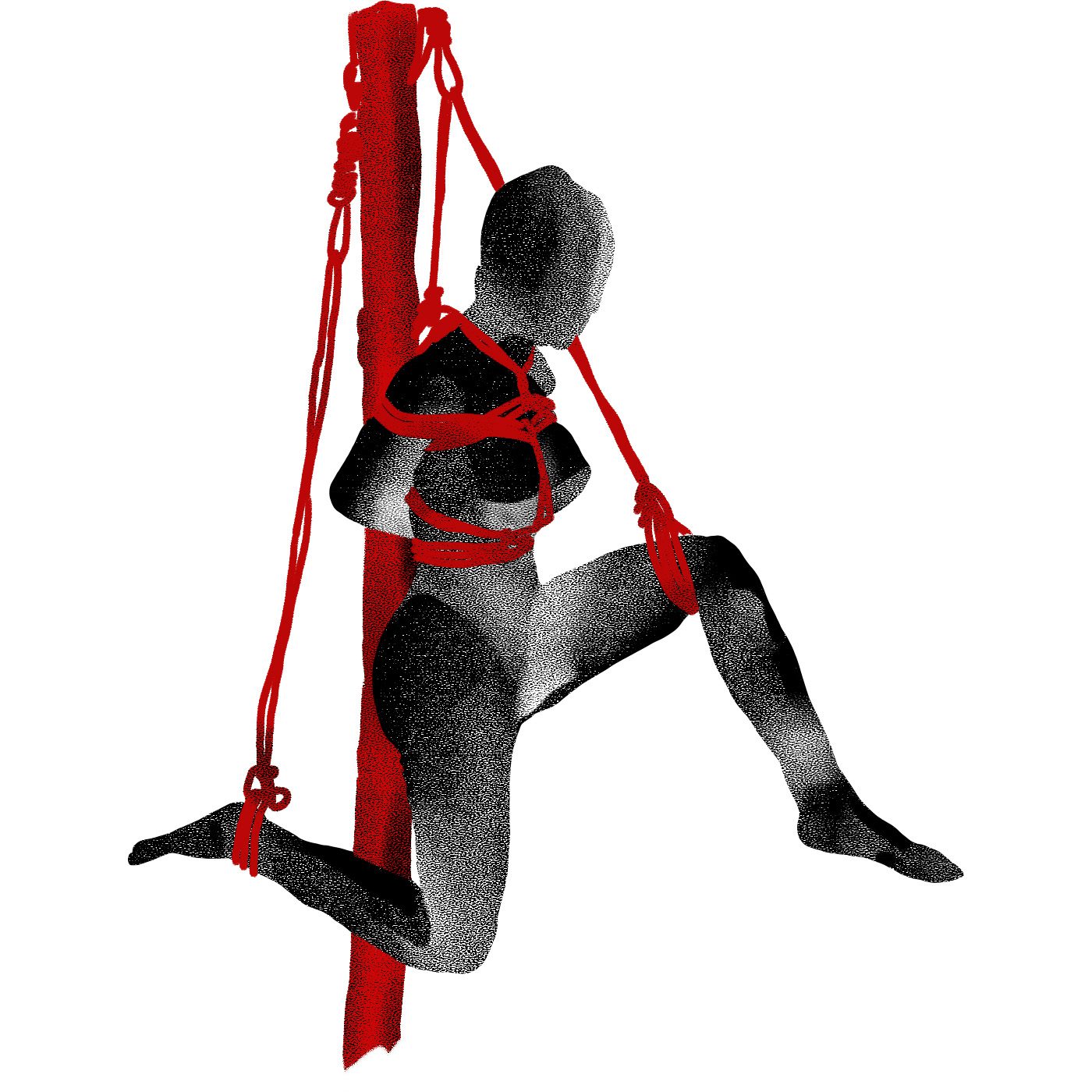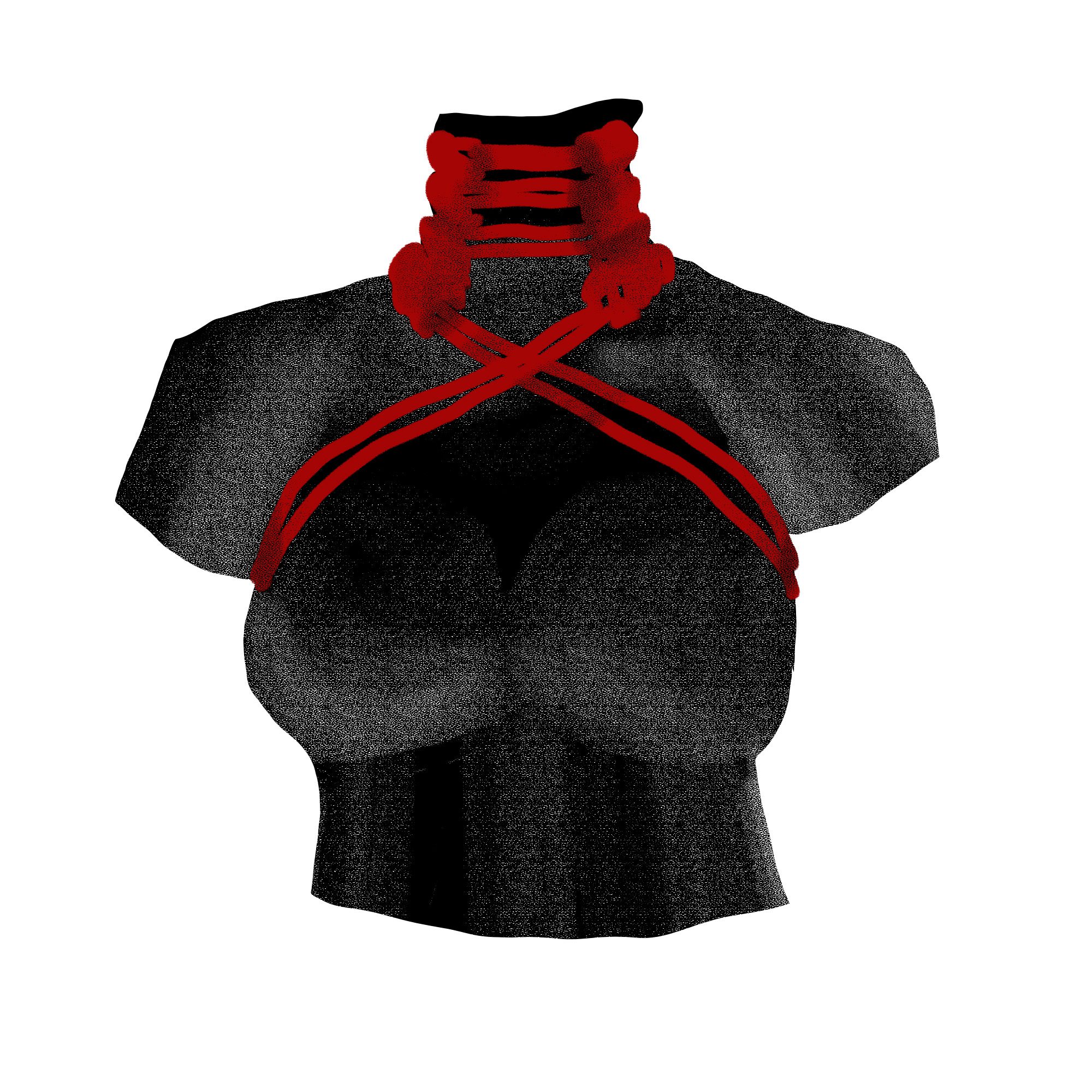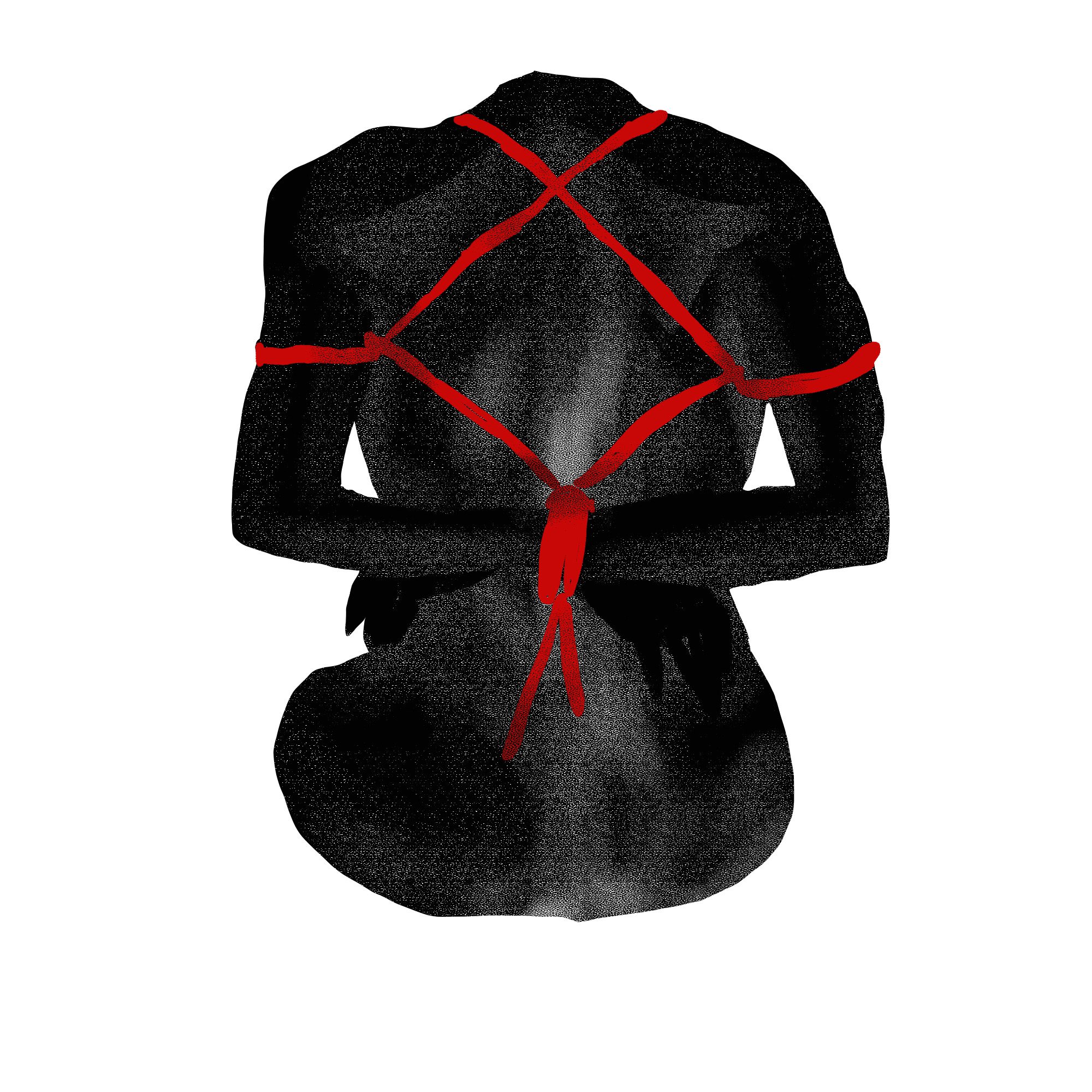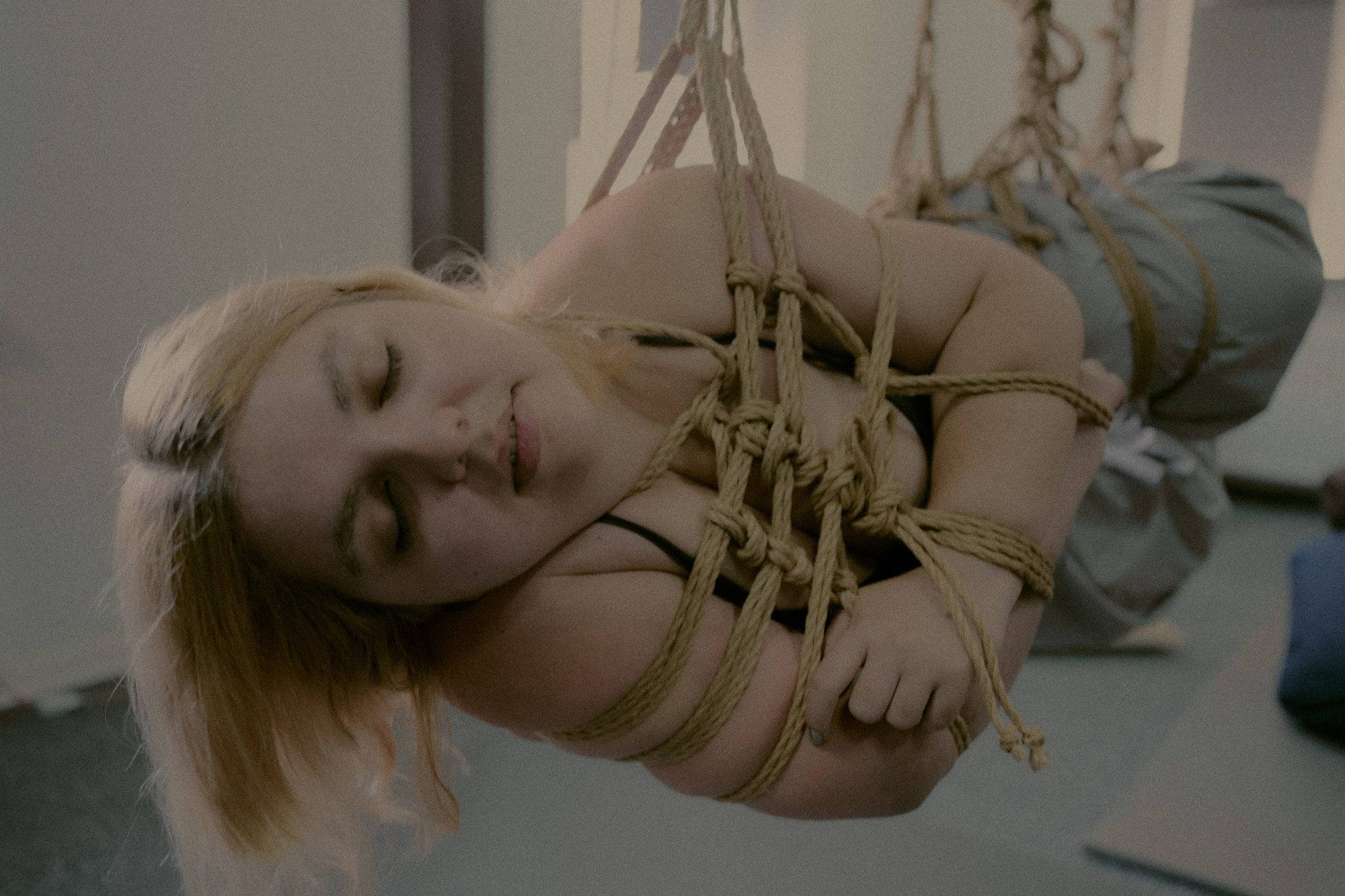Last year, the editor of Zaborona Maria Pedorenko promised herself that she would try anything new that could help her get rid of obsessive and negative thoughts. Instead of traditional yoga and meditation, she went to a shibari session — a Japanese aesthetic (and often erotic) bondage that takes away the feeling of control over one’s body and, at the same time, inspires a sense of freedom. This is what came of it.
If you know what shibari is, how to practice it, and how it became a part of BDSM culture, you can scroll down. Although we recommend you stop and read.
Where did shibari come from?
The word “shibari” literally means “to bind.” However, in Japan, it is used literally for everything: if you receive a package tied with a bundle, it is also shibari. And for the erotic bondages compared to art, in Japan, they use the term kinbaku — “the beauty of tight binding.”
Views on the roots of kinbaku differ. There is a very romanticized theory about the connection between erotic bondage and Japanese martial arts. One of its branches is the hojojutsu technique, which was actually the forerunner of handcuffs. Prisoners were tied with ropes or cords to be immobilized as much as possible. Still bound, they were sent to prison and taken out for execution.
The father of modern kinbaku is the Japanese artist Seiyu Ito who, from early childhood, had been fascinated by images of torture in plays and engravings. He began as an author of theater posters, but later focused on paintings with a familiar plot. Naked or half-naked women in wooden shackles and ropes wandered from one piece to another. He photographed his models and then transferred the images to engravings. Perhaps his most famous work is “Photo of a gracefully suspended pregnant woman in the last month of pregnancy” (1920), where he captured his second wife, the actress Kise Sahara.
Ito died at the age of 79. At the time of his death in 1961, the erotic bondage had already gained wide popularity. From photos in erotic magazines to thematic performances and feature films — the kinbaku technique turned into art: underground, specific, and for some very taboo.
What are the shibari patterns?
Easy

Agura — crossed legs 
Takate Kote — hands tied behind the back 
Hishi Karada — a rope dress
Medium difficulty

Shinju — “a pearl” 
Ebi — “a shrimp” 
Teshibari — a sleeve
Difficult

Hashira — “vertical beam” 
Kinoko — a neck corset 
Hojōjutsu Ittatsu-ryu — “school of Hojōjutsu”
Want to try shibari? This is what the masters advise:
- it is better to start with an offline lesson so that the master can correct your actions in case of a mistake;
- basic anatomy will come in handy — it’s worth knowing the location of muscles and nerve nodes so that you don’t tie them up in the process;
- do not tie up armpits or place knots below the knee, on the inside of the wrist and thigh;
- refrain from tying the neck altogether if you do not have enough experience;
- do not practice shibari while under the influence of alcohol or drugs;
- discuss your wishes with your partner in advance — you should make sure that both of you are comfortable;
- the person being bound should inform about their old or new physical injuries to prevent retraumatization;
- the same with psychological injuries or phobias — although it’s easy to quickly release a person who is having a panic attack, it’s better not to let that happen at all;
- ask the person being tied up if there are any parts of their body that must not be touched, and do not ignore the partner’s requests;
- in the process, ask how the bound person feels — if the limbs get numb, offer to massage them or eventually release them if it did not help;
- if one of the participants wants to stop at any point, do so.
You may say “perversion,” I say it’s not
Torture, executions… Where is the pleasure? Modern shibari/kinbaku masters (they are called nawasi or bakushi) do not really want to talk about the origins of the tradition at all: they say that the romanticized story of strong men taking control over another person’s body is about the traditional distribution of power, dominance, and pressure, and by no means about pleasure, which is based on mutual consent. For them, the Japanese bondage technique is primarily the realization of sexual desires, however, belonging to the BDSM culture is often perceived as something perverse.
In sexology, there is a term “paraphilia,” which denotes unusual sexual interests — BDSM also belongs here, as well as various forms of fetishism. However, social psychologist Justin Lemiller notes that paraphilia does not mean a mental disorder, and such unusual sexual interests are becoming more and more common.
Calming down the control freak
A horned head looks aggressively at me from the white wall. The empty pupils are downcast, there is a branch of dried flowers in its teeth, and the furrowed eyebrows are curved in an inverted letter J.
“This is Khanya,” a long-haired girl with a large ink mandala on her shoulder explains. “The Japanese have a lot of spirits in Shintoism, and this one inhabits a woman who found out about her husband’s infidelity. In this image, she comes to his lover to scare her. She looks angry, but if you lift her chin, she has a face of despair.” This is Vlada; she is 25 years old and, together with her 26-year-old boyfriend, Vlad, she runs a tea studio in Podil, Kyiv. There are several rooms here, and we sit in the largest one. We pass glasses to each other in a circle, inhaling the tea aroma. I drink one small cup after another, not knowing that later I will be immobilized not only by the rope but also by the strong drink that will hit my head with something similar to a hangover.

Vlad and Vlada. Photo: Olya Koval / Zaborona
“We started as photographers,” Vlad says. He has even more tattoos, but the first thing that catches your eye is his thick beard and the same thick hair tied in a bun.
He’s been shooting nudes for five years when a mother of two asked him in the middle of the photo shoot: “I have a rope. If you want, I can tie myself up, and you’ll take pictures.”
After this phrase, Vlada decided to try the art of bondage. “I imagined I would be sitting in the balcony, smoking a joint, drinking a cup of tea, and in front of me, two naked girls would tie each other up,” Vlad recalls, laughing. “Reality: I’m already drunk and high, and they tell me: “For Vlada to know how [to tie the ropes], I need to show. And I will be showing it on you.”
Vlad was sitting without a T-shirt, felt the rope stinging his body, and realized that he was… Comfortable? “One hand is warm, the other is cold. Everything is slow. I felt totally safe, and it was a shock. I realized that there is something so wide in me,” he spreads his hands, “that it is impossible to limit it with ropes, walls, borders.”
On the same day, Vlad realized: the thing he was critical about turned out to be something completely different. Personally, he divides the practice of shibari into several varieties: performative — when the bondage becomes an element of a show, compensatory — this is how he perceives BDSM, and meditative.
“The last one is closer to me,” he emphasizes. “There is much less sexuality here. I have a basic rule that the first experience of shibari should be exclusively asexual. If you give your brain something labeled as sexual, it will be incredibly difficult to change that label to ‘meditation’ or ‘reflection’.”
“Because you already gave it a sweeter candy,” adds Vlada.

Photo: Olya Koval / Zaborona 
Photo: Olya Koval / Zaborona
Then Vlad began to read my thoughts — I wanted to try shibari so that I could stop being a control freak for at least 10–20 minutes and not try to manage everything that was happening around me.
“Our brain is always thinking about control,” he says. “It’s our basic instinct, and shibari is when your brain isn’t thinking. You are being tied down, and you are consciously transferring responsibility for your body to another person.”
To Vlada, shibari is first and foremost an art. She says she started wondering once whether one life would be enough to try out all the possible creative outlets. Linocuts, printing, photography — and shibari as well. However, when she is in a bad mood or has too many thoughts, she comes to Vlad. “Bind me” — it helps Vlada shift her focus from the outside to the inside, turn off what she calls the “highway in the head,” and get deeper into her body.
Vlad and Vlada have been together for eight years. However, they practice bondage in sex only occasionally, so as not to get bored.
“It helps you try on a different role,” the guy explains, “and feel a certain power.”
“For you – to feel a very specific power,” I blurt out and immediately apologize. But everyone is smiling.
He does not like being tied up in sex. Vlada, on the other hand, sees an opportunity to deepen emotional and physical connection in sexual bondage — there must be trust in the partner to whom you entrust your body. And, of course, attention. Shibari requires concentration, and knowing that all attention is on you is always nice.
“Shall we start with the binding?” Vlad switches his attention from the girl to me.
We move the table aside. I take off my T-shirt and tie my hair up. Vlad sits down in front of me on the carpet and shows me how to put my hands together in a bowl. One, two, three — a rope around the wrists, and once more between the palms. Loop up and up — the long end of the rope pulls my hands behind my head. My back straightens, but I sit with my head humbly bowed.


Photo: Olya Koval / Zaborona 

Photo: Olya Koval / Zaborona
A rhombus appears on my solar plexus, diverging behind the shoulders and back. The rope tingles my body and contrasts with the coolness of the hands that tie me up. Control is lost, but do I feel anything? Meditation does not work — the head is busy comparing expectations to reality. But there are no thoughts about sex either. In the end, Vlad removes the ropes. We put the table back, I get dressed and hug him goodbye. No matter what, trust has emerged between expectations and reality.
A few minutes of peace
At three in the morning, my dog wakes me up with a demanding barking. I shine a flashlight on a water bowl — it is empty. Five steps to the kitchen, and each one gives a dull pain in the lower back. My hand gropes for back ointment in the kitchen cupboard. The dog sits nearby, waiting for water. And I am waiting for the morning, hoping by then to be able to straighten up, as I pull up my T-shirt to rub my lower back.
The day before, I went to the shibari studio and said a bit shyly to the master: “I want you to tie me up and hang me.”
“Are there places I can’t touch?” she asks.
“Probably not. However, I’m not very flexible,” I said after a brief consideration.
Yuliya Vasilieva has been practicing shibari for 15 years, and lately, she has only been binding those who won’t moan or groan — experienced people who know what they are dealing with. It turns out I’m an exception — I consider that an honor.
Her fascination with the art of Japanese bondage began when few people in Ukraine knew about shibari. Vasylieva studied economics in Kharkiv, had a boyfriend, and knew nothing about BDSM. When her partner offered to tie her hands during sex, she agreed. She liked it, except for the itching from the rope.
Basic Internet search showed her Japanese engravings of bound women. The pictures she saw fascinated Yulia so much that soon she and her boyfriend were on their way abroad to their first shibari festival.
“I came back a different person, and I definitely understood that I wanted to live in that 24/7. I remember driving around the city and realizing: this gray life is not for me,” recalls Vasilieva with a smile. “At the festival, people completely devoted themselves to the process, it was an extravaganza of sincerity and trust.”
The master asks not to photograph her — she is convinced she is not photogenic. But even before our meeting, I came across photos from parties with Vasylieva. She looked like a living statuette of ivory: wrapped in red latex, with a fresh cut of black plaid and, of course, red lipstick and manicure.

Photo: Olya Koval / Zaborona
A few years after the first festival, Vasylieva already had a studio in Kharkiv. During the day, she was busy with papers, as her economic education dictated, and already at 6:01 p.m. she left the office to the question of her colleagues: “You have no husband, no children — what’s with all the rush?”
Vasilieva calls her time at the studio a holiday. She witnessed the birth of something new: lovers of shibari and BDSM began to come out into the world — first at anonymous meetings, where asking one’s name and profession was unheard of, later — at mini-parties that spilled over into the underground, and with time, became open to those not afraid to talk about their preferences out loud.
Early on, lack of understanding made it difficult for her to find a studio — either in Kharkiv or in the capital. However, Vasilieva made it a rule not to hide anything from landlords or potential neighbors. Therefore, among the rejections, she finally found a spacious hall on Kyrylivska Street in Kyiv, where lectures and practical lessons for shibari lovers take place today.
A short lecture is waiting for me as well:
- shibari is a part of BDSM, but only one branch of the subculture;
- bondage is not exclusively about ropes; you can immobilize a person with a chain, handcuffs, leggings, or even a robe belt or a blanket;
- anything can be done with a rope — a gentle bondage or a very painful one;
- the most important thing in shibari is control; it constructs a scenario between the participants, and it entails responsibility because the lack of control can turn into a trauma for the bound person.
“I can’t imagine dating someone who doesn’t like ropes,” she notes. “But it so happened that all my partners loved binding.”


Photo: Olya Koval / Zaborona 
I jokingly ask if she is afraid of burning out. But the master laughs because she herself wonders whether she ever gets tired of tying people up.
The closest she came to this was at the beginning of the full-scale Russian invasion of Ukraine. Photos of tortured people with their limbs tied up shocked with their brutality, and Vasylieva began projecting her horror onto shibari. However, later she concluded: “The rope is sacred, and here it is used so shamefully.”
After several months abroad, Yulia returned to Kyiv and surprisingly saw that the studio wasn’t empty. People continued to do what they loved, and along with them came new ones.
“Should I take off my pants?” I ask.
“As you wish.”
Everything begins as the first time: a rope around my wrists, my hands up — only now not behind my head, but above it, where the master fastens them onto the bamboo crossbar. I recall the previous bondage experience out loud, and Vasilieva immediately scolds Vlad: he shouldn’t have started by tying up my hands — that is always a helpless position, as well as tying up my belly, which causes animal fear. Eventually, she completely frees my hands, however, only to tie them again in a minute — this time in a cross on my chest. Her movements are fast and slow at the same time. She runs her palm gently along the stretched skin, and then sharply, in an instant, pulls the rope. My legs bend and lift off the floor, and Vasilieva, looking like a fragile statuette, pulls them up to the level of my hands.

Photo: Olya Koval / Zaborona
I feel sharp pain in my thigh and I moan, but the master will later explain: she did it on purpose in order to switch my brain. I really was stuck in my head again. Do I like it or not? What do I feel? How did she manage to lift me up so easily? How do I look?
When it seems like the end, the master gets behind me and runs her hand through my hair. Loose is not good. She takes it in a noose and ties it to my feet. I stiffen, although it isn’t painful, but rather… Pleasant?
Instead of sexual feelings, I think I got something else: with my body hanging a meter above the floor, I didn’t feel like a tied sack of potatoes, I didn’t feel like a prisoner or a sex toy — I didn’t feel anything at all. And wasn’t it the first time in my life that this emptiness gave me peace and not the desire to fill it?
I returned from the studio with a dotted red pattern of bruises on my back — the master warned me about the marks. However, for the evening walk with the dog, I wore the most revealing top.
“Story announcement,” I said to the barista in my hood, showing the fresh bruises.

